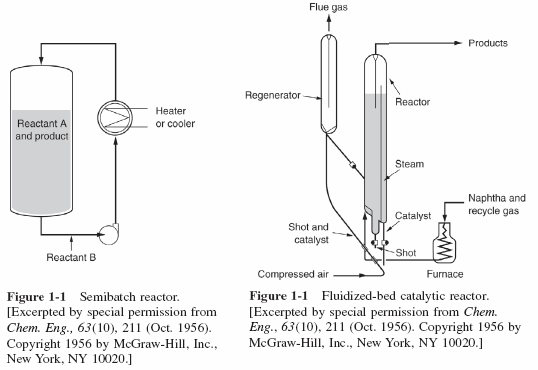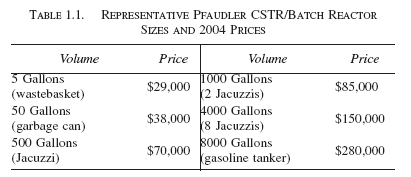[1] Liquid-Phase Reactions. Semibatch reactors and CSTRs are used primarily for liquid-phase reactions. A semibatch reactor (Figure 1-1) has essentially the same disadvantages as the batch reactor. However, it has the advantages of temperature control by regulation of the feed rate and the capability of minimizing unwanted side reactions through the maintenance of a low concentration of one of the reactants. The semibatch reactor is also used for two-phase reactions in which a gas usually is bubbled continuously through the liquid.

A CSTR is used when intense agitation is required. Table 1-1 gives the typical sizes (along with that of the comparable size of a familiar object) and costs for batch and CSTR reactors. All reactors are glass lined and the prices include heating/cooling jacket, motor, mixer, and baffles. The reactors can be operated at temperatures between 20 and 450°F and at pressures up to 100 psi.

The CSTR can either be used by itself or, in the manner shown in Figure 1-2, as part of a series or battery of CSTRs. It is relatively easy to maintain good temperature control with a CSTR because it is well mixed. There is, however, the disadvantage that the conversion of reactant per volume of reactor is the smallest of the flow reactors. Consequently, very large reactors are necessary to obtain high conversions. An industrial flow sheet for the manufacture of nitrobenzene from benzene using a cascade of CSTRs is shown and described in the Professional Reference Shelf for Chapter 1 on the DVD.

If you are not able to afford to purchase a new reactor, it may be possible to find a used reactor that may fit your needs. Previously owned reactors are much less expensive and can be purchased from equipment clearinghouses such as Aaron Equipment Company ( www.aaronequipment.com ) or Loeb Equipment Supply ( www.loebequipment.com/ ).
The tubular reactor (i.e., plug-flow reactor [PFR]) is relatively easy to maintain (no moving parts), and it usually produces the highest conversion per reactor volume of any of the flow reactors. The disadvantage of the tubular reactor is that it is difficult to control temperature within the reactor, and hot spots can occur when the reaction is exothermic. The tubular reactor is commonly found either in the form of one long tube or as one of a number of shorter reactors arranged in a tube bank. Most homogeneous liquid-phase flow reactors are CSTRs, whereas most homogeneous gas-phase flow reactors are tubular.
The costs of PFRs and PBRs (without catalyst) are similar to the costs of heat exchangers and can be found in Plant Design and Economics for Chemical Engineers , 5th ed., by M. S. Peters and K. D. Timmerhaus (New York: McGraw-Hill, 2002). From Figure 15-12 of the Peters and Timmerhaus book, one can get an estimate of the purchase cost per foot of $1 for a 1-in. pipe and $2 per foot for a 2-in. pipe for single tubes and approximately $20 to $50 per square foot of surface area for fixed-tube sheet exchangers.
A packed-bed (also called a fixed-bed) reactor is essentially a tubular reactor that is packed with solid catalyst particles. This heterogeneous reaction system is most often used to catalyze gas reactions. This reactor has the same difficulties with temperature control as other tubular reactors; in addition, the catalyst is usually troublesome to replace. On occasion, channeling of the gas flow occurs, resulting in ineffective use of parts of the reactor bed. The advantage of the packed-bed reactor is that for most reactions it gives the highest conversion per weight of catalyst of any catalytic reactor.
Another type of catalytic reactor in common use is the fluidized-bed reactor, which is analogous to the CSTR in that its contents, though heterogeneous, are well mixed, resulting in an even temperature distribution throughout the bed. The fluidized-bed reactor can only be approximately modeled as a CSTR; for higher precision it requires a model of its own. The temperature is relatively uniform throughout, thus avoiding hot spots. This type of reactor can handle large amounts of feed and solids and has good temperature control; consequently, it is used in a large number of applications. The advantages of the ease of catalyst replacement or regeneration are sometimes offset by the high cost of the reactor and catalyst regeneration equipment. A thorough discussion of a gas-phase industrial reactor and process can be found on the Professional Reference Shelf of the DVD for Chapter 1. The process is the manufacture of paraffins from synthesis gas (CO and H 2 ) in a straight-through transport reactor.